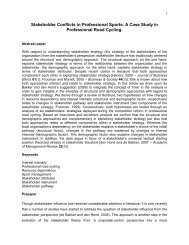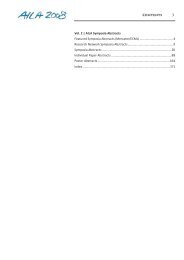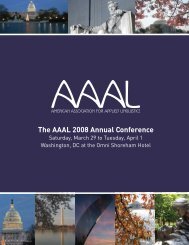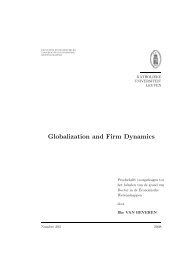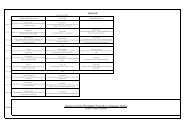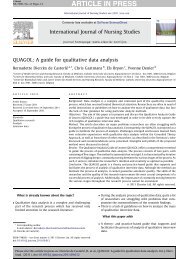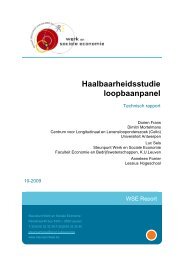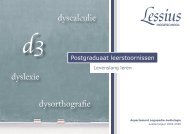The role of implicit attitudes towards food and ... - ResearchGate
The role of implicit attitudes towards food and ... - ResearchGate
The role of implicit attitudes towards food and ... - ResearchGate
Create successful ePaper yourself
Turn your PDF publications into a flip-book with our unique Google optimized e-Paper software.
44 M. Craeynest et al. / Eating Behaviors 9 (2008) 41–51<br />
six months later (T2), <strong>and</strong> at follow up one year after completing the program (T3). Concerning T2, the participants<br />
were not exactly tested at the end <strong>of</strong> their treatment, as this moment was different for each <strong>of</strong> them. Each time, height,<br />
weight, <strong>implicit</strong> <strong>and</strong> self-reported <strong>attitudes</strong> were assessed. For practical reasons, the first measurement was completed<br />
at the Department <strong>of</strong> Moving <strong>and</strong> Sports Science <strong>of</strong> Ghent University, whereas the second measurement was completed<br />
in the residential setting. For the one year follow up, the children were invited to the residential setting for a general<br />
check-up. Sixteen youngsters <strong>of</strong> the test group showed up. <strong>The</strong> other three were tested at home.<br />
All children were tested individually. <strong>The</strong> order in which the two EASTs were administered, was counterbalanced.<br />
<strong>The</strong> questionnaire was completed after both EASTs were conducted. Each EAST consisted <strong>of</strong> three different blocks.<br />
Before each task, the participant provided words for physical activities or <strong>food</strong>s that he/she really (dis)liked. Next, in a<br />
first practice block, these individually selected attribute words appeared r<strong>and</strong>omly four times in a white colour on the<br />
screen. Participants were instructed to classify these words according to their valence as quickly <strong>and</strong> as accurately as<br />
possible, by pressing the m-(positive) or the q-(negative) key <strong>of</strong> an AZERTY keyboard, in order to learn an extrinsic<br />
association between a positive (negative) valence, <strong>and</strong> the left (right) key. In a second practice block, each target<br />
stimulus was presented in at least once in blue <strong>and</strong> once in green. In the <strong>food</strong> task 12 trials were presented, <strong>and</strong> in the<br />
activity task 24 trials. Half <strong>of</strong> the participants pressed the m-key in response to green words <strong>and</strong> the q-key in response to<br />
blue words; the others pressed the m-key in response to blue words <strong>and</strong> the q-key in response to green words. In this<br />
way, they learned an association between a key carrying a valence <strong>and</strong> a colour. Finally, each task consisted <strong>of</strong> four<br />
crucial test blocks in which a mix <strong>of</strong> target <strong>and</strong> attribute words were presented. <strong>The</strong> physical activity task contained four<br />
test blocks <strong>of</strong> 32 trials (14 white trials, 18 coloured trials) each; the <strong>food</strong> task contained four test blocks <strong>of</strong> 38 trials each<br />
(14 white trials <strong>and</strong> 24 coloured trials). <strong>The</strong> words had to be classified depending on valence (for white words) or colour<br />
(for green <strong>and</strong> blue words). Stimuli were always presented in a r<strong>and</strong>om order, whereby the mixed blocks did not<br />
necessarily alternate between target (coloured) <strong>and</strong> attribute (white) stimuli. <strong>The</strong> inter-trial interval was 400 ms. If the<br />
participant responded incorrectly, a red cross appeared for 400 ms on the screen <strong>and</strong> the next stimulus was presented.<br />
2.5. Statistical analyses<br />
Analyses were carried out using SPSS 12.0 for Windows. <strong>The</strong> analyses <strong>of</strong> the EASTs took only the responses on the<br />
coloured test trials into account, whereby trials with an incorrect response were discarded (De Houwer, 2003). In line<br />
with Greenwald et al. (1998), reaction times (RTs) below 300 ms or above 3000 ms were recoded to 300 ms <strong>and</strong><br />
3000 ms respectively. All RTs were log-transformed. Also mean percentage <strong>of</strong> errors (PE) were analysed. On the selfreports,<br />
<strong>attitudes</strong> <strong>towards</strong> sedentary activities, moderate intense physical activity (PA), high intense PA, unhealthy <strong>food</strong><br />
<strong>and</strong> healthy <strong>food</strong> were obtained by averaging the respective item scores. Evolutions in mean <strong>attitudes</strong> were calculated<br />
conducting Repeated Measures ANOVA's. <strong>The</strong> explaining variance <strong>of</strong> attitudinal changes during treatment for the<br />
decrease in overweight during treatment <strong>and</strong> at follow up was analyzed using covariate multiple regression analyses.<br />
3. Results<br />
3.1. Mean <strong>implicit</strong> <strong>and</strong> self-reported <strong>attitudes</strong> at baseline<br />
A 3 (word category: sedentary activities vs. moderate intense PA vs. high intense PA)×2 (extrinsic response<br />
valence: positive vs. negative) Repeated Measures ANOVA on the baseline reaction times <strong>of</strong> the physical activity task<br />
showed no significant effects, all Fsb2.85. Also the same 3×2 Repeated Measures ANOVA conducted on the baseline<br />
percentage <strong>of</strong> errors revealed no effects, all Fsb2.19. However, a 2 (word category: unhealthy vs. healthy <strong>food</strong>) ×2<br />
(extrinsic response valence: positive vs. negative) Repeated Measures ANOVA on the baseline reaction times <strong>of</strong> the<br />
<strong>food</strong> task showed a significant main effect <strong>of</strong> valence, F(1, 18)=6.08, pb.05. This indicates that the participants were<br />
positive <strong>towards</strong> both healthy <strong>and</strong> unhealthy <strong>food</strong>, which was also found in the total group as described in Craeynest<br />
et al. (2005). No other effects were found, all Fsb1. Also the same 2 ×2 Repeated Measure ANOVA conducted on the<br />
percentage <strong>of</strong> errors, revealed no effects, all Fsb2.49. A three-level within factor (word category: sedentary activities<br />
vs. moderate intense vs. high intense PA) Repeated Measures ANOVA on the self-reported <strong>attitudes</strong> <strong>towards</strong> physical<br />
activity, showed a significant effect, F(2, 17)=5.54, pb.05. Post hoc paired sample t-tests showed that moderate<br />
intense PA was rated more positive than sedentary activities, t(18) =3.08, pb.01, <strong>and</strong> high intense PA, t(18) =2.61,<br />
pb.05. A two-level within factor (word category: unhealthy vs. healthy <strong>food</strong>) Repeated Measures ANOVA on the




